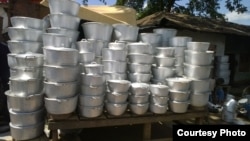Locally made aluminum pots and pans are very common in Africa and Asia.
But a new study in Cameroon has raised questions about their safety, saying high levels of lead are leaching from the cookware into food.
The World Health Organization has not posted any regulations regarding lead in cookware, but the U.S. Centers for Disease Control has said there’s really no safe level of lead exposure.
Ashland University and Occupational Knowledge International conducted the research in Cameroon that appears in the journal Science of the Total Environment.
“I must say we literally stumbled upon this," said Perry Gottesfeld, Occupational Knowledge International’s executive director. "We were working in Cameroon for the past four years. We had been doing awareness sessions and outreach around lead in paint trying to get companies there to reformulate to take out the lead additives and to get the government to put in regulation. And in the process the question had come up – well, what about the pots?”
The lead awareness campaign was done in partnership with the Education Center for Development, a Cameroonian NGO.
“Our partners went out and visited where these are made and reported back that, in fact, this is made primarily from scrape metal. And so that of course peaked our interest. And that’s when we decided to do an investigation to find out what the levels of lead and other heavy metals were in those pots,” said Gottesfeld.
The researchers wanted to know how much lead was being served with daily meals. Gottesfeld said lead exposure has effects that are both acute and chronic.
“We found that the average or median level was about 97 micrograms of lead per serving – serving size being about 250 milliliters. So this is a very high concentration of lead and a type of exposure that people would likely get on a regular, daily basis if using this kind of cookware.”
That’s hundreds of times higher than the level the U.S. State of California has determined to be the Maximum Allowable Dose per day.
Gottesfeld said, “In terms of low-level lead health effects that occur on an ongoing basis like this one, we could expect neurological damage that’s manifested in reduced performance in school – reduced IQ – and other learning disabilities. We also know though that it affects the health of an individual throughout their life and does result in higher rates of heart disease and stroke. And it doers result in a very high death rate among populations who are exposed long term.”
He said that there are reports that similar lead levels are found in locally made aluminum cookware in Thailand and Bangladesh. He said taking steps to eliminate the lead-laced pots pose challenges.
“I think the first question we need to ask is how extensive is this problem. But ultimately I think it’s going to require some regulation on the part of government. But also it’s going to require working with these local manufacturers to educate them about the kinds of scrape metal that they should and shouldn’t use in making this kind of cookware.”
He said the scrap metal could be tested for lead before it’s melted down to make cookware. This could be done with a portable device called X-ray fluorescence, or XRF, which gives results in a matter of seconds. Researchers are considering a pilot project to determine whether on-site testing is feasible in Cameroon.
Another option is to have the cookware manufactured with a process called anodization. It places a coating on aluminum that reduces the amount of lead and other metals leaching into food.
“We know that lead poisoning is a huge problem throughout Africa, but almost all of it goes undetected because there are no facilities to test for blood lead levels in most countries in Africa. So we know that there are literally millions of children and adults, who are overexposed to lead. And they just continue to suffer with these symptoms and they’re often misdiagnosed with some other unrelated disease,” said Gottesfeld.
Occupational Knowledge International recommends that African laboratories have the capacity to conduct tests for blood lead levels. Field tests are also available.
Gottesfeld added that awareness campaigns are needed for those who run the small companies that manufacture the pots.
“We would like to follow-up by doing more outreach and education with these manufacturers so that they better understand the kinds of scrape that contain higher levels of lead and other contaminants. Clearly, if they were using pure aluminum this would not be a problem.”
He said recent surveys in Africa and Asia “suggest blood lead levels have remained stubbornly high despite the ban on lead gasoline in most of the world.”













